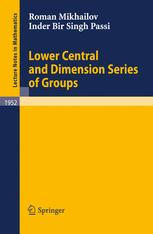

Most ebook files are in PDF format, so you can easily read them using various software such as Foxit Reader or directly on the Google Chrome browser.
Some ebook files are released by publishers in other formats such as .awz, .mobi, .epub, .fb2, etc. You may need to install specific software to read these formats on mobile/PC, such as Calibre.
Please read the tutorial at this link: https://ebookbell.com/faq
We offer FREE conversion to the popular formats you request; however, this may take some time. Therefore, right after payment, please email us, and we will try to provide the service as quickly as possible.
For some exceptional file formats or broken links (if any), please refrain from opening any disputes. Instead, email us first, and we will try to assist within a maximum of 6 hours.
EbookBell Team

4.3
8 reviewsA fundamental object of study in group theory is the lower central series of groups. Understanding its relationship with the dimension series, which consists of the subgroups determined by the augmentation powers, is a challenging task. This monograph presents an exposition of different methods for investigating this relationship. In addition to group theorists, the results are also of interest to topologists and number theorists. The approach is mainly combinatorial and homological. A novel feature is an exposition of simplicial methods for the study of problems in group theory.